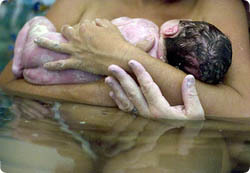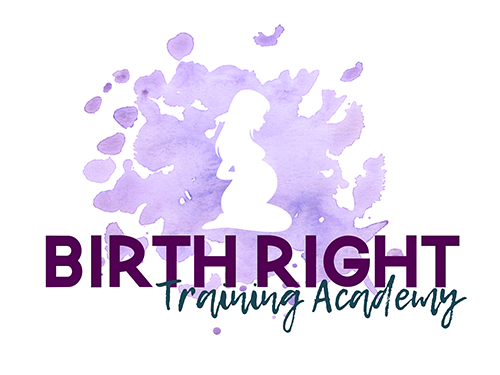Waterbirth
 Probably because we begin our lives surrounded by water, most people find great repose with water. For thousands of years women have been using water for labour and birthing, they have used it ritually, and find great comfort in being immersed during labour. If there is a birthing pool or bath available to a woman in labour, it is very common, at some stage during labour, for her to gravitate to the water. It works its magic, especially for a woman who is anxious and physically very tense. This is no different than using water at other times in our lives. There is nothing more relaxing at the end of a stressful work day, or if you feel unwell or anxious, to relax, either in a shower or a bath. You can feel your tense body becoming more relaxed as it is bathed in warm water.
Probably because we begin our lives surrounded by water, most people find great repose with water. For thousands of years women have been using water for labour and birthing, they have used it ritually, and find great comfort in being immersed during labour. If there is a birthing pool or bath available to a woman in labour, it is very common, at some stage during labour, for her to gravitate to the water. It works its magic, especially for a woman who is anxious and physically very tense. This is no different than using water at other times in our lives. There is nothing more relaxing at the end of a stressful work day, or if you feel unwell or anxious, to relax, either in a shower or a bath. You can feel your tense body becoming more relaxed as it is bathed in warm water.
Known benefits of waterbirth:-
Can speed up labour
The effect of buoyancy allows spontaneous movement
Free from gravity
Reduces blood pressure
Can relieve anxiety
Many women report that water takes away 50-60% of uncomfortable sensations
Promotes relaxation
Conserves energy
Reduces the need for medical intervention, including drugs
Many women feel it is a private and protected space
Reduces perineal trauma and the need for an episiotomy
Encourages an easier birth
Provides a gentle entry into the world for the baby
If this is what triggers a labouring woman to relax, with sensory stimulation reduced, your body is less likely to secrete stimulating related hormones. This allows your body to produce the pain inhibitors that complement labour. A relaxed body equals a relaxed mind. Many women doulas and Midwives acknowledge the analgesic effect of water in labour.
Who Can Have a Waterbirth?
1. First question to ask when shopping around for a place to give birth is does the facility provide for waterbirth. Not all hospitals have a deep bath suitable for a waterbirth. It is generally only available in a Birth Centre setting or at home, where you can hire a birthing pool. Some Delivery suites have a ‘token gesture’ bath, which is often a normal size bath and not suitable for a waterbirth. The bath needs to be deep enough for a pregnant belly to be fully immersed, to be able to enjoy the benefits of floating. Do not just assume if there is a bath in the room that waterbirth is a service that is provided.
2. Second question to ask is are all Midwives skilled and trained in waterbirths if that’s what you decide to do on the day. There are some facilities that provide the bath, and then on the day of birth, don’t have a Midwife who is skilled at waterbirth. This can be hugely disappointing for a woman who has chosen a place to give birth, based on the fact that waterbirth is an option, only to discover that the Midwife or obstetrician on the day, asks you to get out of the bath to birth. This is not an issue if you are birthing at home.
How will the Baby Breathe?
Babies do not drown if they are born underwater! The baby is receiving oxygen from the placenta through the cord which continues to provide oxygenated blood while he responds to the new stimuli and fills his lungs with air for the first time. They live in water (amniotic fluid) until labour begins their transition from the uterus to the air-filled world outside. It is a common policy in most hospitals that when baby is born that they are lifted onto their Mum, so head out of the water and body still floating in the warm water. They generally don’t cry and appear very calm and alert, especially if the environment is dark and quiet.
Common Myths about Labouring in Water
- Ruptured Membranes (broken waters) – there are still hospitals that will not ‘allow’ women with ruptured membranes to labour in water. There are no studies, to date, that indicate any associated risk. If the membranes have been ruptured for longer than 18 hrs., there is a slight risk of infection, whether a woman is labouring in or out of water.
- If a woman is not in good established labour then being in water may be so relaxing that labour either slows or stops and the opposite can also be true
- Drink plenty of fluids as dehydration is more common if labouring for a long time in water.
- It is time to get out of the bath if labour slows or stops
There are other ways to use water if the place where you are birthing does not provide waterbirth. Using the shower, straddling a chair with running water is using both gravity and water. The use of hot/cold packs can also be beneficial.
Once a woman has experienced a waterbirth, there is overwhelming evidence that she will want to have all her babies in water.
All hospitals should be providing this option for women.
If you are in a situation where your local hospital does not provide this option then CHANGE will only occur if women demand this choice be provided. All women should have the option of birthing in water. You won’t know, until you are in labour, where you want to give birth, or in what position., but you should have the choice.




